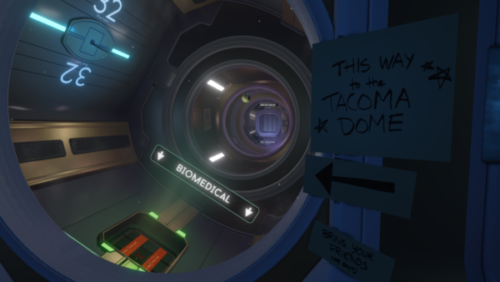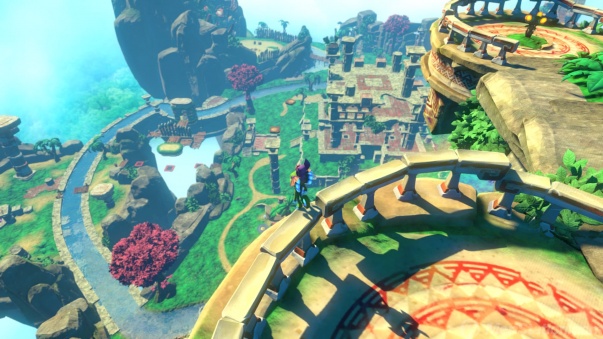Few creative debuts reverberate as powerfully as Fullbright’s. By 2013, the likes of Dear Esther and Journey had prepared a template for the narrative-based exploration genre, but Gone Home is widely recognised for elevating the style with cohesive storytelling and truly relatable concerns.
The last four years have evolved the genre beyond staid wandering, increasing engagement through player agency, and Fullbright’s sophomore effort deepens this well of innovation.
To justify the expanded range of interaction, Tacoma moves the action from a sprawling mansion in America’s Northwest to a derelict space station, yet manages to retain the profound sense of humanity that permeated Gone Home.
Tacoma is keenly aware that silence can be as powerful as the loudest explosion. In the wake of whatever disaster has befallen the Tacoma space station, the rooms and halls are eerily quiet.
The only sound is the soft, omnipresent drone of life-sustaining machinery that, far from reassuring players, creates tension by serving as a reminder of the protagonist’s precarious position.
Something has gone wrong, and safety is not guaranteed in these devastated corridors. The silence of the main character, Amitjyoti (Amy) Ferrier, who speaks no more than a dozen lines across the two-hour adventure, reinforces the oppressive atmosphere.
Like the player, Amy is an observer, uncovering the events surrounding the cataclysmic systems failure aboard the station, but either unwilling or unable to pass judgement.
Assuming the role of narrators are the Tacoma’s crew members, absent in body though present as augmented reality (AR) projections reflecting past events.
While these ‘memories’ do speak and provide updates on the most recent developments, silence remains paramount, punctuating dialogue to convey indecision, affection, fear, and a host of other emotions without the need for life-like visuals or convincing lip-synching.
This low-key approach to sound design and utter lack of exposition gives the game a meditative air that invites players to explore the environment and enjoy the sights at a sedate pace.
The wisdom of this design ethos cannot be understated, as most of what Tacoma has to say is shared through the economic use of words, body language, and the evidence of the environment.
Visual simplicity is a hallmark of the adventure, which allows small details to take on great importance. An earlier build of Tacoma featured a much more extravagant aesthetic, beginning with players stepping into a vast, art-deco lobby dominated by golden tones and vibrant vegetation. The release version discards that vision for a sterile and straightforward interpretation of near-future technology.
Bold lines continue to guide the architectural design, but they serve a cleaner aesthetic where primary and secondary colours create a sense of cleanliness and utilitarianism. The swept-clean feeling so prominent in the communal areas is overturned entirely in the crew’s personal quarters, where the eye for detail shown in Gone Home returns with stunning results.
Through no more than a few scattered notes, books, and miscellaneous possessions, Fullbright brings to life each of the six personnel, revealing the insecurities and softer selves hidden beneath the business-focused personalities of the communal areas.
The simplicity makes the set dressing believable, and the decision to eschew realistic character models in favour of roughly-drawn, brightly-coloured holographic approximations of people helps to invest players in the fiction.
The sci-fi mystery of Tacoma is less compelling than the family drama of Gone Home, but Fullbright’s enviable storytelling talent lifts the game above many other so-called walking simulators. As mentioned earlier, exposition is almost entirely cast aside in Tacoma, leaving the narrative to unfold organically through dialogue and environmental cues.
Using these most basic elements of the writer’s toolkit, Fullbright delivers a masterclass of interactive fiction. Every word, object, and surface serves a purpose. Amy is onboard Tacoma to collect the wetware for the station’s AI, ODIN, and the return it to the manufacturers at the Venturis Corporation for analysis.
This main plot provides reason to explore, but lacks excitement, even with the presence of an eleventh-hour twist. Furthermore, the mystery of what went wrong on the station fails to be as interesting as the developers intend, with the Eureka moment easily foreseen. Instead, the brilliance of the game stems from the characters.
With Fullbright’s attention spread across six characters (or seven, counting ODIN), players are never able to emote with any of them as fully as with Gone Home’s Sam. Nevertheless, each character feels well-rounded, and the developers are careful to spend time exploring their strengths and weaknesses, bravery and fears, and concerns and desires. In the same vein, the dedication to diversity is commendable, as the crew members are drawn from a wide pool of races, creeds, and sexualities, though the lack of commentary on these traits suggests an element of tokenism. Thankfully, this narrative choice does not detract from the story, instead seeming to cast a blanket classification of human over everyone aboard Tacoma. Instead, the thematic musings of the game rest on ideas of corporate avarice, the echoes of the past on the present, and the reliance on the digital world, which apparently remain as present in 2088 as in 2017. However, such issues are mused upon in the background, with the profoundly fraternalistic sentiment of shared humanity being foregrounded through the myriad character interaction, which would not be possible without the ability to play with time.
Temporal manipulation is not a new concept for games, emerging in franchises as diverse as God of War, Titanfall, and All Walls Must Fall, but Tacoma’s use of the mechanic for narrative purposes is novel. As Amy moves through the various modules of the station, she unlocks AR recordings of the crew. With these memories frequently ranging across several rooms and amongst different character groups, the player cannot remain a passive observer and see the full story. Uncovering every detail requires players to pause and rewind the recordings, following the various crew members from place to place. Furthermore, accessing the crew members’ AR dashboards provides further messages and news articles, offering deeper insights into the individual characters, their feelings at any given time, and the wider themes of the project. These additional interaction mechanics are entirely justified by narrative and add another layer to the experience, but do not, by any means, reinvent the first-person exploration genre, which is true of Tacoma as a whole.
Like Gone Home previously, Tacoma is one of the most cohesive games of recent times. Fullbright’s focus on silence and simplicity has paid off, resulting in an incredibly engaging and satisfying journey. The central narrative is less interesting than it might have been and the closing moments could be handled better, but these are minor quibbles in a game that is, in every other respect, masterful.



